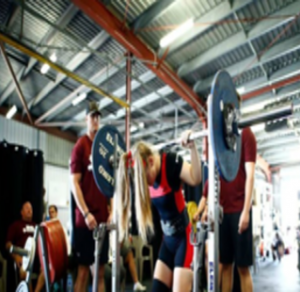Low-Bar Squat High-Bar Squat


V’s
High-Bar v’s Low-Bar Squat?
There is no incorrect answer!
Whether you choose to use a high-bar or low-bar squat will depend on multiple factors, such as goals, gym, age, and injury history. Though both high-bar and low-bar squats are both squats, and they can both be used to supplement each other, the bottom line is that at the end of the day they are both very different lifts and they rely on different movement mechanics and transfer of forces.
In general, high-bar squats are used by the population at large in the gym as well as by weightlifters, CrossFit athletes, and cross-training athletes, for example. As for low-bar squats, powerlifters often use them when competing on the platform. You also find that athletes training for strong man competitions usually use low-bar squats.
Barbell Placement For The Squat…
As the name implies, in a low-bar squat the bar is placed on the back across the spine of the scapula. In other words, the bar is resting on the posterior deltoid. On the other hand, with high-bar squat the bar is placed on the upper back, lying above the shoulders, just below the C-7 vertebrae. A very common mistake untrained gym-goers make is placing the bar too high thus putting pressure directly on the C-7. This is why they often get pain in the neck and sometimes in the hand. We will discuss this type of neural pain in our next article. You will often see people using a foam pad or a towel to minimise the pain they feel when they are doing a high-bar squat, but the fact of the matter is that this pain is caused by the weight pressing against the C-7.
How does the Squat Work?
Now let’s break down how the squat works. With a low-bar squat, you have a wider foot placement than with a high-bar squat. Your hips are pushed back and you will have a slight forward lean and, in general, a wider hand grip. The width of the grip depends on the individual.
On the other hand, with the high-bar squat, you typically have a narrow stance and lifting shoes with a heel are used to assist with this movement. Your hips are directly under the bar and you hold your chest nice and tall and your hands have a narrower grip. But just like with the low-bar squat, the grip depends on multiple factors that are different with each person. There is no size fits all hand grip.
Low Bar Squat

The Benefits of Low-Bar Squat …
The low-bar squat is generally used for two main reasons, one of which is to build up the posterior chain. This build-up occurs because the low-bar squat forces the hips back to produce and absorb the force. This creates the forward lean of the chest and, in general, allows lifters to lift heavier weight. This is why we generally see this type of squat used in powerlifting, where the aim is to squat as much as possible to depth and to be able to grind your way out of that hole. Low-bar squats ensure that the torso can be horizontal while the load shifts more into the posterior. This allows the glutes and hamstrings to be more involved and requires less range of motion from them. When the torso is upright like it is when we are performing a high-bar squat, this limits the ability of the body to get out of the hole when under a substantial load. This is why, for powerlifting, the low-bar squat is a platform favourite for most coaches and lifters.
Low Bar Squat

The Benefits of High-Bar Squat …
High-bar squats are the most basic form of squatting and resemble a position stance used in general day to day living. They also typically have a positive spillover into weightlifting and most performance sports as they build certain muscle groups along with building core strength and improving posture.
In our next article, we will look at how to choose your squat variation in order to minimize injury risk and improve platform performance.
About the Author:
Hannah Altman is a qualified exercise scientist BHS| BCOM | MPHIL, and Strength Coach Fitrec, a Pilates instructor and Nutrition Coach PN1 Elemental L2, focusing on injury prevention for strength athletes. She is currently studying for her doctorate at Queensland University of Technology.
She holds multiple junior bench-press records, the current one being 95kg and has a top bench-press of 103kg at 69kg body weight. She is ranked in the top 20 in Australia based on Wilks in all three lifts and in Bench-Press.
She currently coaches out of Iron Underground in Albion, Brisbane and online.
To book a complimentary session; to get a 10% discount for rehab, prehab or just performance and to increase your bench, choose from the options below. Contact Hannah on 0452285271.
